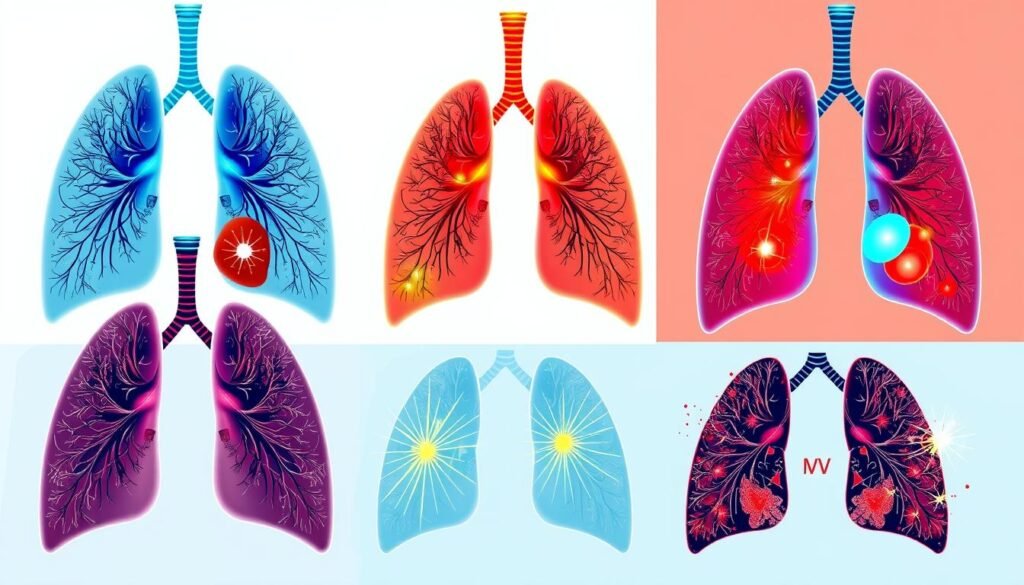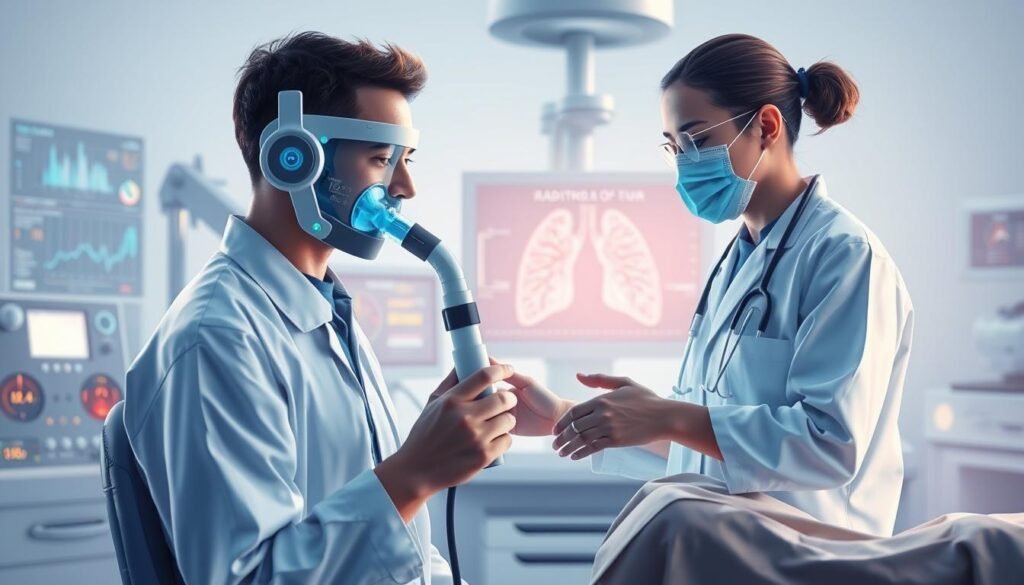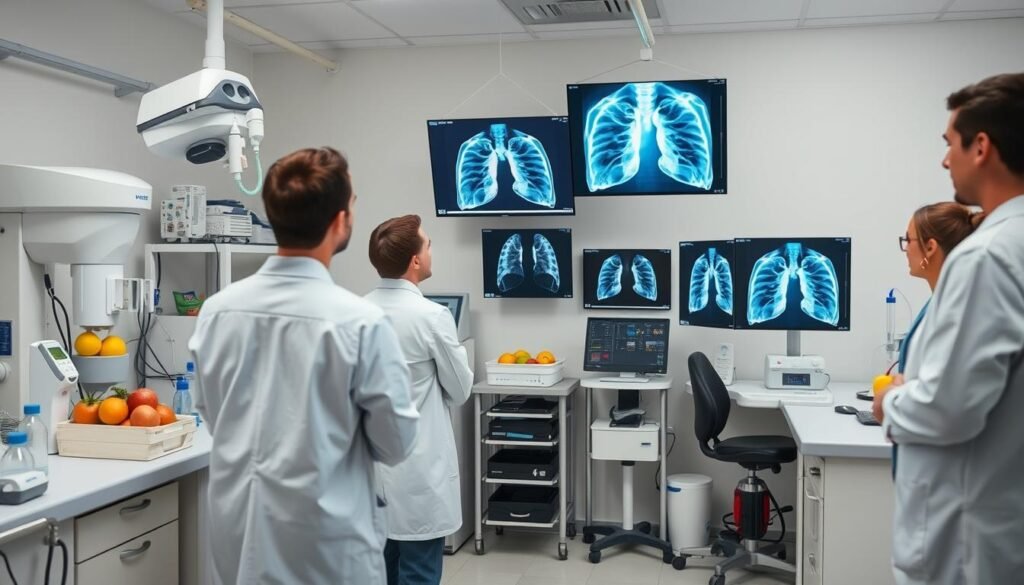Did you know radiation therapy can help control lung cancer in up to 95% of cases for three years after treatment? However, this success comes with big challenges. Patients often face serious lung issues after thoracic radiation therapy. This includes conditions like radiation pneumonitis and pulmonary fibrosis after 5-7 weeks of treatment.
These treatments do more than fight cancer. They can cause lasting lung damage, leading to constant shortness of breath and coughing. It’s vital for patients to understand how radiation therapy affects their lungs over time. This guide will help you grasp the effects of radiation and discuss ways to lessen the damage.
Want to know more about how radiation affects the lungs and how to manage it? You can find detailed information here. Let’s improve life quality for those dealing with lung cancer treatment side effects together.
Key Takeaways
- Radiation therapy for lung cancer has a high local control rate but can lead to serious long-term lung complications.
- Patients should be aware that short-term side effects often evolve into long-term issues like chronic cough and shortness of breath.
- Engaging healthcare providers about treatment side effects is crucial for effective management and support.
- Newer radiotherapy techniques aim to minimize damage to healthy tissues while effectively targeting cancer.
- Awareness of symptoms related to radiation pneumonitis and pulmonary fibrosis can facilitate early intervention and care.
- Support systems are essential for addressing the physical and emotional challenges of lung cancer survivors.
- Regular lung function monitoring is vital in managing long-term effects after radiation treatment.
Understanding Radiation-Induced Lung Effects
Radiation therapy plays a key role in lung cancer care. But, it can also harm lung health. Mainly, it causes inflammation and fibrosis in the lungs. These problems come from the body’s response to radiation.
Statistics show that 5% to 58% of patients develop lung injuries from radiation. Up to 20% experience serious lung damage with modern radiotherapy. Treatment schedules impact these rates. Daily treatments raise the chance of severe side effects to 43%. Meanwhile, less frequent treatments only have a 7% chance of serious issues.
Mixing chemotherapy with radiation boosts the risk of radiation pneumonitis. The risk is 1.6 times higher for those getting both treatments at once. Tumors in the mid to lower lung are more likely to cause this problem. Also, patients with COPD face higher risks from radiation.
It’s crucial to understand radiation’s side effects. This knowledge helps make safer treatment plans. Chronic pneumonitis can lead to pulmonary fibrosis if ignored. Signs like fever, cough, and breathing trouble could mean radiation pneumonitis. Watching for these symptoms is important for patients getting lung cancer treatment.
Types of Lung Injuries Caused by Radiation
Radiation therapy is crucial for treating cancers, but it can hurt the lungs. It’s important to know about radiation pneumonitis and pulmonary fibrosis, the main types of lung injuries. Understanding their timelines and symptoms helps patients and doctors alike.
Radiation Pneumonitis
People often get radiation pneumonitis two to three months after their treatment. They might feel short of breath, have a dry cough, and face other breathing problems. About 9.4% of patients undergoing stereotactic body radiation therapy for non-small cell lung cancer might experience it. Combining chemotherapy with radiation increases this risk significantly. For example, using paclitaxel with radiation for breast cancer can increase the risk from 1.1% to 14%. Recognizing these signs early is key to effective treatment.
Pulmonary Fibrosis
Pulmonary fibrosis can take months or even years to show up, usually happening six to twenty-four months after therapy. It causes the lung tissue to scar, making it hard to breathe. This condition often follows radiation pneumonitis. The risk of developing pulmonary fibrosis goes up with higher radiation doses, especially over 40 Gy. Even though some may initially show signs of pneumonitis, not all progress to serious fibrosis. Knowing the symptoms and how to manage them can improve a patient’s life greatly.
Both conditions, radiation pneumonitis and pulmonary fibrosis, require careful monitoring and treatment. Researchers are constantly looking for better ways to prevent and manage lung injuries from radiation. For in-depth information on radiation-induced lung injuries, check out this resource.

| Condition | Onset Timeframe | Common Symptoms | Risk Factors |
|---|---|---|---|
| Radiation Pneumonitis | 2-3 months post-treatment | Shortness of breath, dry cough | High total radiation dose, concurrent chemotherapy |
| Pulmonary Fibrosis | 6-24 months after treatment | Progressive coughing, decreased lung function | Cumulative radiation dose, prior pneumonitis |
Signs and Symptoms of Lung Damage Post-Radiation
Radiation therapy is widely used to treat many types of cancer. After this treatment, patients may notice several signs of lung damage. These can be immediate or appear later. Knowing these signs helps people get care quickly and look after their health.
Dyspnea and Nonproductive Cough
Dyspnea means having trouble breathing. It is a key sign of lung damage after radiation. It often comes with a dry cough, which does not bring up mucus. If you have these symptoms, watch your breathing health closely. They can be early signs of lung damage. Spotting symptoms of radiation pneumonitis early is key for getting help and managing the issue. These breathing problems can start weeks to months after treatment, so stay alert.
Fever and Chest Fullness
Feeling a fever and fullness in your chest can also mean lung damage. These issues may be caused by inflammation or infection from the radiation. Getting checked by doctors is vital to find out why you feel this way. Sometimes, these symptoms point to radiation-linked lung injury. For more help and personalized advice, look at detailed side effect information.
| Symptom | Description | Potential Causes |
|---|---|---|
| Dyspnea | Difficulty breathing | Radiation-induced lung injury, pulmonary fibrosis |
| Nonproductive Cough | Cough without mucus production | Symptoms of radiation pneumonitis, inflammation |
| Fever | Elevated body temperature | Infection, inflammatory response after radiation |
| Chest Fullness | Sensation of pressure in the chest | Pneumonitis, lung fibrosis |
Spotting these symptoms early is critical for taking care of patients. Seeing healthcare providers regularly and keeping an eye on lung health can prevent serious respiratory complications later.
Dealing with the Long-term Effects of Radiation on the Lungs
It’s key to manage lung health when getting radiation treatment. Checking health often and taking steps early can make life better. By watching lung functions and dealing with issues, patients can make smart choices for a healthier future.
Monitoring Lung Function
Keeping an eye on lung health regularly is important after radiation. Doctors suggest lung tests to check how well lungs work. These tests show if lung health changes, helping to spot problems early.
Recognizing and Addressing Respiratory Complications
After radiation, watch out for breathing issues. This includes getting sick often, coughing a lot, or feeling short of breath. Working with doctors to find solutions helps patients keep their lungs healthy. This team effort helps tackle problems and keep lungs strong.

| Monitoring Techniques | Purpose | Frequency |
|---|---|---|
| Pulmonary Function Tests | Evaluate lung capacity | Every 6-12 months |
| Chest X-rays | Identify structural changes in lungs | Annually |
| Symptom Assessments | Track changes in respiratory health | As needed |
Impact of Radiation Therapy on Quality of Life
Radiation therapy affects more than just physical health. It deeply impacts patients’ quality of life. They face both physical and emotional challenges during and after treatment. Knowing about these challenges helps in providing proper support.
Physical and Emotional Challenges
Many patients deal with fatigue and shortness of breath, even long after treatment ends. Research shows that issues like coughing improve after treatment. Fatigue and breathing problems saw significant improvement, with notable statistics to back this up. Facing lung cancer also brings emotional hardships, like anxiety and depression. This highlights the need for wide-ranging care.
Support Systems and Resources
Strong support networks are crucial for those recovering from lung cancer treatment. Connecting with doctors, family, and support groups helps emotionally. These connections provide needed help to navigate recovery. Being part of a supportive community improves mental health and life quality post-treatment.
Current Treatment Options for Long-term Lung Damage
Many treatments can help with long-term lung damage from radiation therapy. These treatments aim to ease symptoms, better lung function, and improve life quality. Knowing about these treatments and medication roles is key to overcoming these challenges.
Lung Disease Treatment Protocols
Long disease treatment mixes drugs and therapy. Techniques like 3D-CRT and IMRT focus on the tumor but protect healthy tissues. Doctors often use these with EBRT to treat non-small cell lung cancer.
- External Beam Radiation Therapy (EBRT): Often chosen for its success and ease of use.
- Proton Therapy: Ideal for Stage III lung cancer; it lessens harm to healthy organs.
- Stereotactic Body Radiation Therapy (SBRT): Delivers high doses in fewer visits; mostly for early-stage cancers.
Medications and Therapies
Medications are crucial for dealing with lung damage side effects. Steroids, for example, help lower inflammation from radiation pneumonitis. New therapies keep improving results by tackling issues like breathlessness and tiredness in patients.
| Treatment Option | Type | Benefits |
|---|---|---|
| EBRT | Conventional | Works against many lung cancers |
| Proton Therapy | Advanced | Less harm to healthy organs |
| SBRT | Focused | More intense, fewer treatments |
| Corticosteroids | Medications | Reduce inflammation and discomfort |

Role of Respiratory Rehabilitation
Respiratory rehabilitation is key in helping lung cancer patients recover after radiation. Its main goal is to better lung function and overall health. It includes exercise techniques for lung health to build endurance and strength.
Exercise and Breathing Techniques
Regular exercise can make a big difference in how far patients can walk and their fitness. For example, a study showed a group doing specific exercises walked 56.6 meters more over eight weeks. Meanwhile, a group that didn’t exercise walked 13.8 meters less. These exercises not only improve physical health but also help with mental well-being by reducing anxiety and fatigue.
Breathing techniques like pursed-lip and diaphragmatic breathing are also taught. They better oxygen intake and ease shortness of breath. This makes everyday tasks easier.
Nutrition and Dietary Considerations
Nutrition is vital for lung cancer patients’ recovery. Around one-third may become malnourished, affecting their health and treatment outcome. The rehab team, including dietitians, stresses balanced meals to keep up strength and energy. They work with doctors and physical therapists to set up nutrition plans that meet treatment goals and enhance life quality.
A team approach, which includes focus on exercise and diet, improves respiratory rehabilitation results. This helps manage side effects of treatments like chemotherapy and radiation. It aids in maintaining an active lifestyle during cancer treatment. For further information on exercise and nutrition in lung recovery, current studies are a great resource.
The Importance of Regular Lung Function Monitoring
Monitoring lung function is key for people who have had radiation therapy. It catches any big changes and handles complications well. Those who keep up with their check-ups tend to have better health results.
In a big review, many studies showed that lung health could drop after treatment. This shows why it’s so important to check lung function often.
Assessing Changes Over Time
Patients need to keep seeing their doctors, especially soon after their treatment ends. For those who beat lung cancer, doctors suggest check-ups every 3 to 6 months for the first two years. Then, visits can be less frequent.
Watching how lung function changes helps spot problems early. Quick action can then be taken to keep lungs working well.
Engaging with Healthcare Providers
Talking with doctors during visits builds a good team for patient care. Telling them about new symptoms, like being short of breath, is key. This helps doctors adjust treatments if needed.
Getting regular scans can also spot if the cancer comes back or if there’s something new. Being an active part of health talks is crucial for good lung care in the long run.